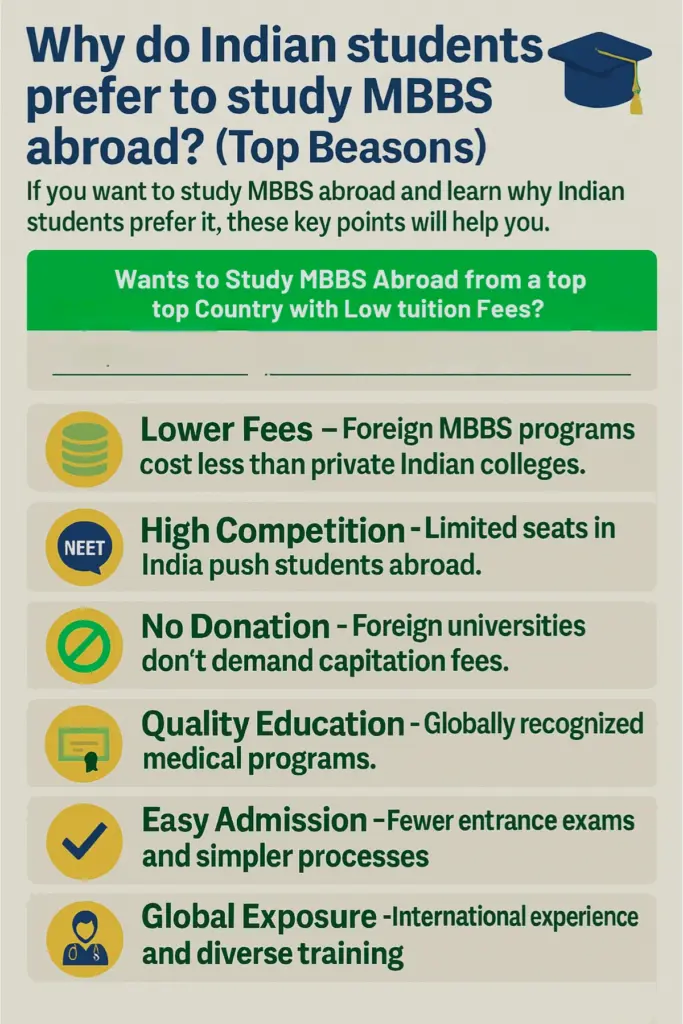MBBS Abroad: The NEET UG 2025 exam saw a record-breaking 23 lakh aspirants registering for it. This figure exposes the increasing gap between India’s demand for medical education and its limited supply of MBBS seats. With just about 1.18 lakh MBBS seats nationwide, and only 56,000 in affordable government medical colleges, lakhs of deserving candidates are left without options.
For these students, studying MBBS abroad is no longer a luxury or an adventurous alternative it is a necessity. In the light of exorbitant private college fees and intense domestic competition, foreign universities offer a affordable and better alternative to fulfil the dreams of becoming a doctor.
NEET UG 2025: MBBS in Govt College in India
Securing an MBBS seat in a government medical college in India is extremely challenging due to limited seats, intense competition, and high cut-off scores.
- Firstly, despite increasing number of NEET-UG aspirants crossing 23 lakh in 2025, only around 56,000 government MBBS seats are available nationwide, making the acceptance rate very low.
- Secondly, the cut-off scores for government colleges, especially in top states like Delhi, Maharashtra, and Tamil Nadu, often reach above the 98th percentile, leaving only the top rankers with a realistic chance.
- Lastly, aggressive reservation policies and state quotas further reduce the number of open category seats, forcing lakhs of deserving candidates into either costly Private Medical Colleges in India or MBBS Abroad options.
Private MBBS in India: A Distant Dream for the Middle Class
Even students securing decent NEET ranks often find themselves unable to grab a government seat and equally unable to pay private college fees. For these students:
- Private colleges demand ₹15–25 lakh per annum, excluding hostel and other costs.
- Capitation fees and hidden charges are common despite regulations.
- Seats under the NRI quota (sometimes ₹30–40 lakh) are often out of reach for ordinary Indians.
Studying MBBS abroad becomes the most logical and affordable alternative.
7 Reasons Why Students Choose MBBS Abroad
1. NEET UG 2025: Ever-increasing competition in India
India’s medical entrance exam, NEET (National Eligibility cum Entrance Test), is now one of the most competitive exams globally.
- 23 lakh aspirants in 2025
- Only 1.18 lakh MBBS seats
- Just 56,000 government seats are affordable to the middle class
This means that over 21 lakh students will have no direct MBBS opportunity in India this year, unless they can afford private medical colleges, where fees can easily cross ₹60 lakh–₹1 crore for the full course, an impossible dream for most middle-class families.
2. Relaxed Admission Criteria Compared to NEET
Foreign medical universities offer flexible eligibility criteria:
- Based on Class 12th scores, entrance exams may not be mandatory.
- MBBS colleges in Georgia do not require an English language test as English is the academic language.
- Holistic admission policies ensure deserving students get a fair chance without the bottleneck of NEET’s extreme competition.

3. Modern Infrastructure and Early Clinical Exposure
Many Indian colleges suffer from:
- Overcrowded classrooms,
- Outdated labs,
- Limited patient exposure.
On the contrary:
- Foreign institutions in Georgia, Russia, Kazakhstan, and Malaysia provide simulation-based learning, advanced laboratories, and modern teaching aids.
- Students gain early hands-on clinical training starting from the 2nd or 3rd year itself, unlike Indian colleges, where actual patient handling starts after the 4th year.
4. Globally Recognised Degrees with Licensing Pathways
Reputed foreign medical universities are:
- Listed in the World Directory of Medical Schools (WDOMS).
- Approved by ECFMG, WFME, and WHO, making their graduates eligible for exams like USMLE (USA), PLAB (UK), and others.
- Graduates can practice medicine in countries like the USA, UK, Canada, Australia, and India (after qualifying FMGE).
5. Affordable Education Compared to Indian Private Colleges
Foreign MBBS programs in countries like Georgia, Kyrgyzstan, Russia, and Nepal are affordable:
- Total MBBS cost: ₹30–45 lakh, including tuition, hostel, and food.
- Some universities also offer scholarships and instalment-based fee structures.
Compared to around ₹1 crore in India’s private sector, this is a big relief.
6. Diverse Student Base and Global Perspective
In today’s globalised healthcare world, working with diverse cultures is crucial. Abroad, Indian students:
- Share classrooms with peers from Asia, Europe, Africa, and America.
- Learn cross-cultural communication, adaptability, and tolerance, important component for global medical practice.
This exposure also helps Indian students prepare for global licensure exams and multicultural healthcare environments.
7. Structured Pathways for PG Specialisation
In India:
- PG (MD/MS) seats are far fewer than MBBS seats.
- The competition is brutal even after MBBS.
Abroad:
- US, UK, and some European universities offer direct PG pathways like USMLE (USA), PLAB (UK), or AMC (Australia).
- Several countries allow foreign graduates to apply for residency/match programs based on merit and exam scores.
This opens doors to secure and prosperous careers globally.
MBBS Abroad is Not a Compromise, but a Calculated Choice
Earlier, studying MBBS abroad was seen as an inferior or risky option. But today’s reality tells a different story:
- India’s domestic medical education system is overburdened and expensive.
- MBBS abroad offers modern education, global recognition, and affordable costs.
- Countries like Georgia, Russia, and the Central Asia have become trusted MBBS destinations, especially for Indian NEET qualifiers who just missed government seats but deserve better opportunities.
Also Read: Why Indian Students Are Choosing Russia & Georgia Over India?
India’s Medical Education Crisis is Driving Global Aspirations
The NEET-UG 2025 surge to 23 lakh aspirants has once again highlighted the severe mismatch between demand and supply in India’s medical education system. With limited MBBS seats and unaffordable private options, lakhs of Indian families are forced to look abroad, not out of luxury but a necessity.
Foreign MBBS education offers affordable fees, excellent infrastructure, early clinical training, global exposure, and clear postgraduate pathways, making it a wise and strategic career move rather than a last resort.
As India struggles to expand its medical education capacity, this “study MBBS abroad” trend will only intensify, shaping the future of healthcare talent not just for India but for the world.


